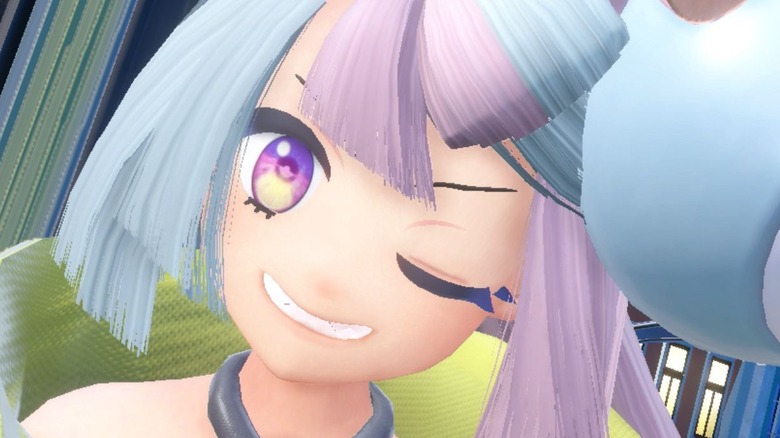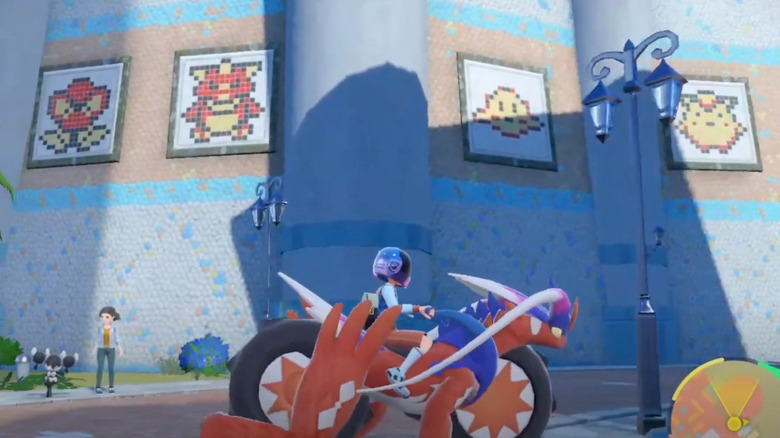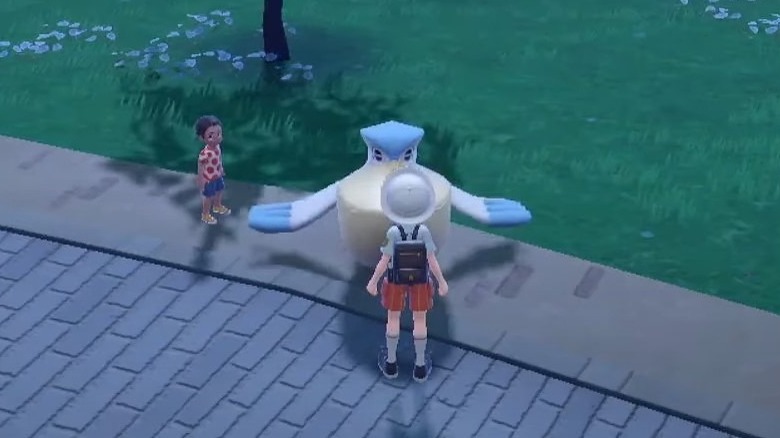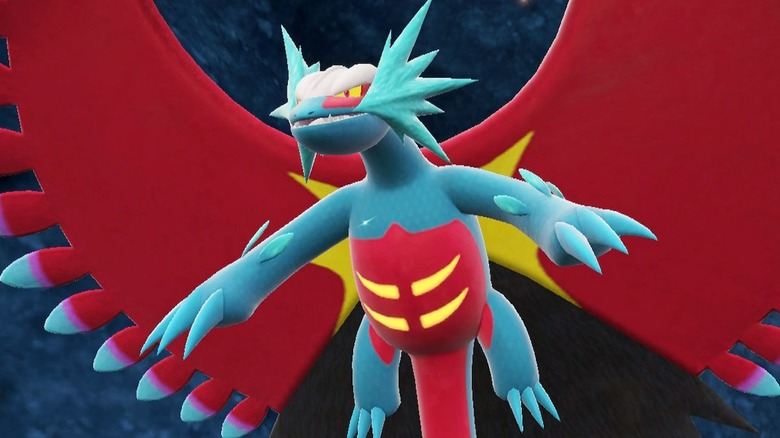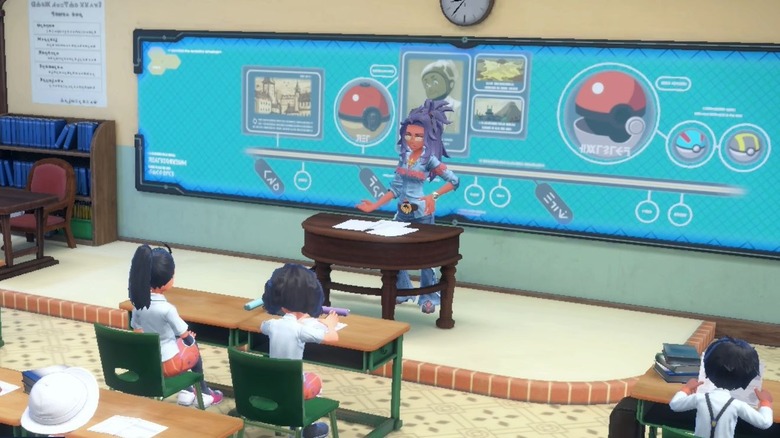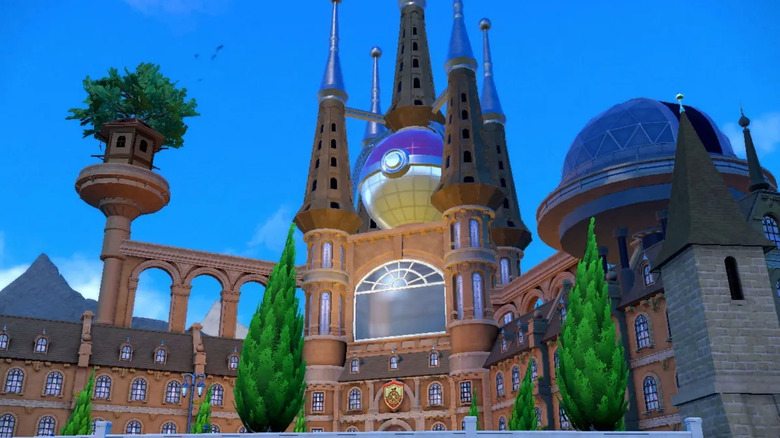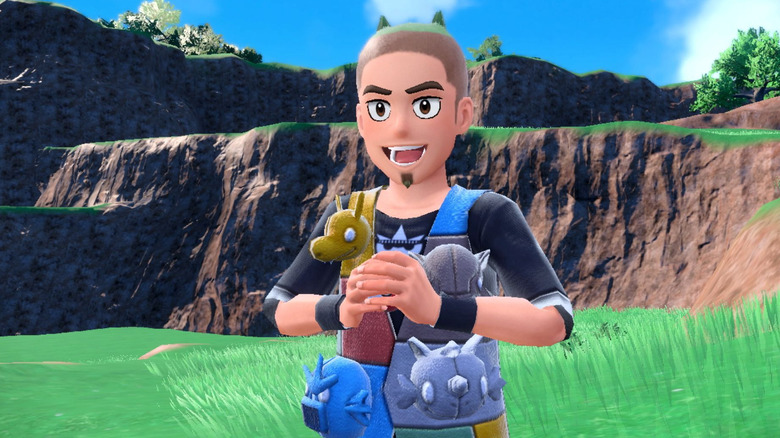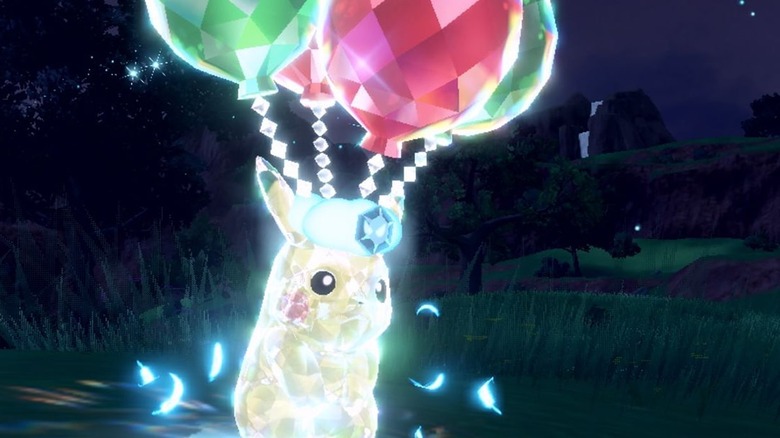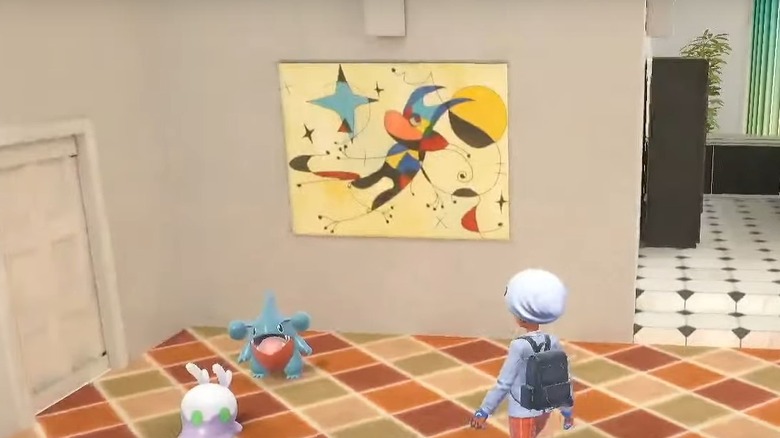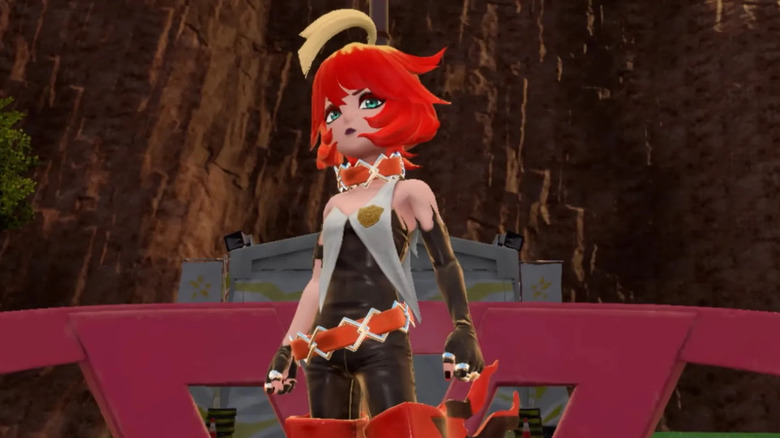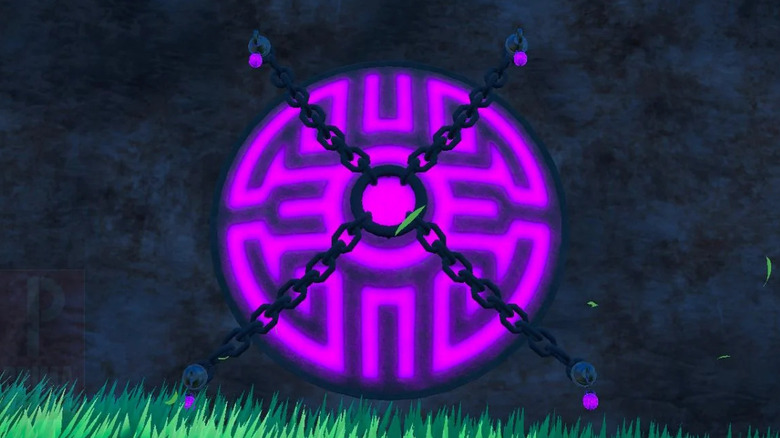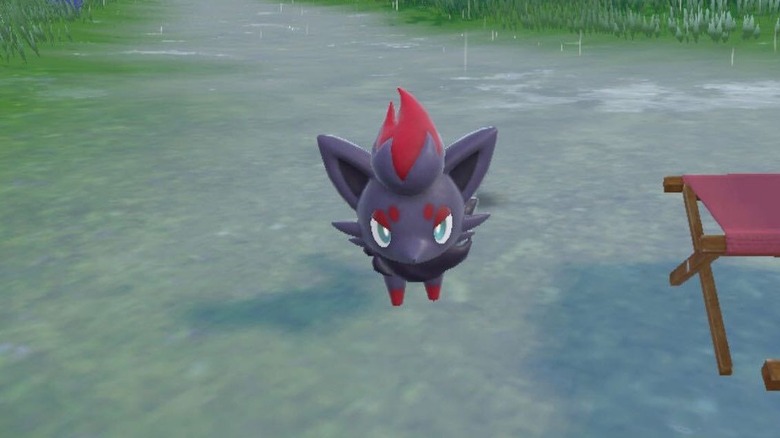Small Details Only Pokémaniacs Noticed In Pokémon Scarlet & Violet
The newest generation of "Pokémon" has arrived with the release of "Scarlet" and "Violet." The games take players to the new region of Paldea, a larger open world bursting with just over 100 new Pokémon.
The game's open world allows players to explore Paldea in pretty much any order they choose, seamlessly traveling from the wild to urban environments. With the new generation's expanded scope and freedom, the developers at Game Freak also had the opportunity to sprinkle more details, easter eggs, and nods to previous games than ever before. It all adds up to make exploring Paldea a real treat.
As a series, "Pokémon" tends to gear its easter eggs towards experienced players who have a bevy of knowledge and experience with the franchise. These references and specific features reward players who search through a game's hidden corner, and "Scarlet" and "Violet" have some that only dedicated Pokémaniacs may catch and understand.
Red and Blue's menu sprites
When players reach the small mountain town of Alfornada, they are able to challenge the region's psychic gym for a badge. Longtime players, however, may get a bit distracted by some of the mosaics on the outside of the gym on their way up. This is because players who are familiar with the very first "Pokémon" games, "Red" and "Blue," will recognize the mosaics as Pokémon menu sprites from the classic titles.
These sprites were used on the party screen for the original Game Boy titles to communicate what type each Pokémon was. While some particularly important Pokémon got their own unique sprites, many received the generic ones, like a bug with six legs or an angry-looking flower.
This easter egg is a really fun reference for fans who have been with the series since the beginning, and it's a callback that doesn't stick out like a sore thumb. Even if one doesn't know what the sprites are, they still look like fun mosaic decorations that feel right at home in Paldea. The mosaics also stand as a great way for players to reflect on just how much the "Pokémon" series has transformed since its original releases.
Pelipper the mailman
While players travel along Route 10, they can come across a trainer standing next to the road with their massive Pelipper. The trainer's name is Postman Harper, which sets up two fun easter eggs for players who jump into battle with them. It is snowing at the start of the battle, but when Harper sends out their Pelipper, the surroundings suddenly switch to rainy weather instead. After the player defeats the Pelipper, Harper sends out Noctowl, a nocturnal bird Pokémon.
This procession of weather effects and Pokémon has been pointed out by some fans to be highly reminiscent of the unofficial creed of the United States Postal Service, which reads, "Neither snow nor rain nor heat nor gloom of night stays these couriers from the swift completion of their appointed rounds" (per USPS Blog).
The second fun easter egg from this interaction is in the use of the Pelipper itself. When the player first talks to Postman Harper, they mention that Pelipper are large enough to carry mail or even entire packages in their beaks for people. This would seem to be a direct nod to the Pelipper Post Office that is found in the "Pokémon Mystery Dungeon" series, and fits in perfectly with the battle's other references to the profession.
Roaring Moon's descendant
Over the course of "Scarlet" and "Violet," players discover ancient Pokémon that are thought to be ancestors to the current known breeds, as well as Pokémon that appear to be future evolutions of the ones we know. These are known collectively as Paradox Pokémon, but they also have their own unique names as well. One of the ancient-looking ones is Roaring Moon, which appears to be the ancestor of the Salamence evolution line.
Roaring Moon's appearance is particularly close to that of its descendants because of how similar it looks to Salamence's Mega Evolution. For one thing, both feature similar wings that create a crescent shape arcing over their head. If players manage to capture Roaring Moon in "Violet," their Pokédex mentions the similarity as well. The entry states that Roaring Moon's appearance "has some connection to a phenomenon that occurs in a certain region."
This entry points to the Mega Evolution phenomenon and raises some interesting questions regarding Mega Evolutions in general. If Salamence's Mega Evolution resembles its ancient ancestor, it could hint to Mega Evolutions drawing on the genetic history of Pokémon in some way. It also raises some questions about the future of "Scarlet" and "Violet," since Roaring Moon appears in Paldea, which does not include the Mega Evolution mechanic — at least not yet. Maybe that's an avenue that could be explored in future DLC.
True 'Legends'
"Scarlet" and "Violet" also feature an easter egg that ties it to 2022's prequel entry in the series, "Pokémon Legends: Arceus." As pointed out by Twitter user @blaze148920, this easter egg is can be seen in the history class that players can attend at Paldea's Oldest School. To catch it, players have to keep an eye on the board behind the teacher during their lessons, otherwise it is easy to miss while reading the dialogue bubble at the bottom of the screen.
@Pokemon nice little easter egg to legends arceus in history class pic.twitter.com/4HIT3VwWjl
— lee douglas (@blaze148920) November 18, 2022
During one lesson, the board shows what appears to be the timeline of the development of the iconic Pokéball. This includes showing the prototype Pokéball that players of "Arceus" are more than familiar with. In addition to the Pokéball, there is also a picture of that game's Professor Laventon. He should be easily recognized by fans, since "Arceus" players have to return to him frequently to turn in their progress for rewards.
The inclusion of references to "Arceus" is also interesting because of how it links the two games together. While "Arceus" is definitely the earliest game in the series chronologically, this is the series' first opportunity to directly acknowledge the prequel's events.
The Oldest School has some good reading
Inside the Academy of "Scarlet" and "Violet," players can visit a massive library filled to the brim with books. By interacting with specific bookshelves, players can actually pull out different books to read. These tomes offer tidbits of history about Paldea, as well as general tips and tutorials to help answer gameplay questions for any newcomers to the series.
However, some of the books also contain fun easter eggs for players to pick up on. One of these connects "Scarlet" and "Violet" directly to "Sword" and "Shield." The book, called "Galar: A History," references the events of the previous-gen games. It is thought to be the book that is being written by Sonia at the end of "Sword" and "Shield," which is a fun tidbit for returning players to find.
[https://mobile.twitter.com/PLDHnet/status/1593734309562974208]
Like the game's previous connections to previous titles, this carries some interesting implications for the "Pokémon" timeline. This instance is particularly interesting, however: "Sword" and "Shield" contain very few direct references to other games in the franchise, making the generation very difficult to place. Now that "Scarlet" and "Violet" are tied to them, however, it means that "Sword" and "Shield" also enjoys those same connections, which helps make the Pokémon franchise as a whole feel even more connected.
Unova's biggest studio lives on
One of the elements of "Pokémon" games that have persisted throughout the generations are the classifications of the enemy trainers that players can encounter in their adventures. While they get re-designed to match the new regions and graphical abilities of each game, players can expect to face familiar trainers like fishermen, backpackers, artists, and dozens more. One of particular interest in "Scarlet" and "Violet" is the Pokémaniac trainer class, because the model's new redesign includes a fun easter egg for players.
Fans noticed the redesign's mostly hidden element quickly: a Pokéstar Studios logo on the character model's shirt. For those who are unaware, Pokéstar Studios is a film studio that appeared way back in "Black 2" and "White 2." The company has never appeared outside of the Unova region, but it brought with it a healthy chunk of side content that saw players to help the studio produce films starring their favorite Pokémon. While some fans hope that it is a sign of remakes on the way for the "Black" and "White" games, this could also just be a fun shoutout the developers added for the sake of eagle-eyed fans.
Flying Pikachu returns
Pikachu is undeniably the most recognizable Pokémon the franchise has ever produced. The adorable yellow electric mouse appears throughout the entire franchise and was made particularly popular through their position as Ash Ketchum's sidekick in the anime series. As a bonus for early purchasers of "Scarlet" and "Violet," players can claim a limited-time Mystery Gift that rewards players with their very own Pikachu. However, this Pikachu is a bit different in that its a Flying Terra type and has a Terra Form that sees balloons suddenly connected to its back.
While this may seem like just a fun and odd choice for inexperienced players, Flying Pikachu actually has a long legacy. Flying Pikachu first appeared as a Pokémon card, which depicted the creature flying in the air with a cluster of balloons tied to his waist. The card has become one of the most coveted in the entire trading card game. Thanks to the popularity of the card, Flying Pikachu also appeared in the menu animation for "Yellow," then went on to appear as an easter egg in titles like "Pokémon Dash" and "Poképark Wii: Pikachu's Adventure." The variant is playable in "Pokémon GO," but now the balloon-heavy monster has become an official piece of battling canon in a mainline game.
An ode to Ash-Greninja
Early on in "Scarlet" and "Violet," players can enter the house of a character named Nemona. Just after entering the house, players can head to the left to find a piece of modern art that doubles as an easter egg for fans of the "Pokémon" anime. While the painting is slightly abstract, fans may recognize that the painting is of a Pokémon known as Ash's Greninja, due to its unique coloring for a Greninja.
For those who don't know, Ash's Greninja is one of the most powerful Pokémon across the entire series, gaining its strength from its uniquely powerful connection with Ash. This boost allows it to transform into a special state – similar to a Mega Evolution – that allows Ash and Greninja to become linked with one another. This increases Greninja's power and abilities, but it also requires Ash to share Greninja's pain throughout the battle. While in the form, Ash also claims that he is able to see through Greninja's eyes and he sometimes mimics Greninja's movements.
The bond between the two is wholly unique in the world of "Pokémon," so it would make sense for residents of Paldea to have heard of it and be inspired to make art like this painting.
Team Star's possible inspirations
The vast majority of "Pokémon" titles feature a team of malicious trainers that act as the game's antagonists. In "Scarlet" and "Violet" that evil Pokémon gang is known as Team Star. Rather than aspiring to world domination or plotting apocalyptic events, however, Team Star is roughly equal to a band of school bullies who torment the students of Paldea's Academy. They are eventually defeated by the player character, who then discovers that the Team was also the victim of bullying. This leads to the team disbanding, though its leader, Cassiopeia, volunteers to take the punishment for the team's actions.
Fans have also noticed that Team Star seems to have taking numerous cues from the history of Japanese cinema. In particular, they resemble a delinquent gang from Japan in the 1980s. Multiple characters within the gang fulfill character archetypes, like the mysterious informant. Interactions with Team Star also feature numerous nods to the Showa era television, such as dramatic flashbacks, speeches about friendship, and playing with a yo-yo at an inappropriate time. And not for nothing, but Team Star's Mela wears boots that wouldn't look out of place on a Power Rangers villain.
While these details will likely go unnoticed by the vast majority of "Scarlet" and "Violet" players, it's a fun addition for those who will pick up on it.
Ancient Pokémon with ties to history
One challenge for players to tackle at the end of their playthroughs is defeating the Treasures of Ruin. The Quartet is made up of four ancient Pokémon that were sealed away years before the start of the game, each locating in shrines found at the four corners of the map. The Pokémon are called Wo-Chien, Chien-Pao, Ting-Lu, and Chi-Yu, and — as noted by Prima Games — they are each heavily inspired by ancient Chinese mythology.
The four Pokémon are said to be the embodiment of the emotions caused by a tyrannical king in Paldea, which may have been inspired by darker times in China's history. Wo-Chien is said to have been created by a scribe writing their grievances against the king on a wooden tablet, which grew to be such a powerful hatred that it was able to manipulate the plant life surrounding it. Chien-Pao is said to have formed out of the hatred of innocents who were slain by the king, empowering it to control hundreds of tons of snow at once to bury the land for good.
Meanwhile, Ting-Lu was created through a crafted vessel that was imbued with a fear of the king that infected the citizens' hearts. This strength enables it to crack open the earth with massive fissures, fracturing the region just as the king's actions did. Finally, Chi-Yu is a fish that controls scorching flames, seemingly due to the destructive envy others held for the king's power.
Hidden Ditto and Zorua
One of the flagship features of the open world in "Scarlet" and "Violet" is the ability for players to observe wild Pokémon wandering about in the open world before entering battles with them. This not only helps players to hunt for particular Pokémon and avoid unwanted battles much more easily, but it allows the game to grant more personality to each creature by allowing players to observe it in its natural habitat.
However, it also allows stealthier Pokémon, like Ditto and Zorua, to hide in plain sight. This is because of Ditto's unique ability to take the form of any other Pokémon and Zorua's ability to create and control illusions. While players are exploring the open world of Pandea, they most likely won't see Ditto or Zorua in their normal forms, even if they're right there on the map. Players will instead see other Pokémon that these creatures are using as disguises.
If a player wants to capture either of these elusive Pokémon, they will need to become familiar with how other Pokémon act in the wild. Even when borrowing their appearance, Ditto and Zorua that are found in the wild won't behave the same way that wild Pokémon typically would. Unless the Pokémon's true name pops up when you sneak close enough, less-experienced players may have a hard time finding them at all, but observant trainers will eventually figure out what kind of body language to look out for.

